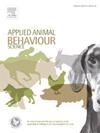Association of sheep (Ovis aries) personality profiles with physiological and productive characteristics under intensive production system
IF 2.2
2区 农林科学
Q1 AGRICULTURE, DAIRY & ANIMAL SCIENCE
引用次数: 0
Abstract
Consistent behavioural patterns defined as personality, are exhibited within individuals over time and across situations. Personality has been associated with the health, welfare and robustness of farm animals. This study aimed to identify the personality profiles of ewes reared under intensive farming and explore links with specific productive and physiological characteristics. To achieve this, 40 adult female sheep (Ovis aries) were studied. The experiment lasted for six months divided into three equal periods (A, B, and C). During period A, the animals were reared in two groups based on their breed. In period B the animals were equally mixed in two groups while in period C the animals returned to their initial state, as in period A. Ewes’ behaviour was recorded during the total experimental period. Based on the social behaviours that remained stable during the examined periods, three personality profiles were recognized (Dynamic, Receptive and Social). Ewes with high scores on the Dynamic profile received affiliative behaviours by more members of the group (p = 0.044) and ewes with low scores spent more time foraging (p = 0.021) and had lower body weight (p = 0.014). In addition, within the receptive profile, ewes with medium scores had the lowest blood cortisol as a response to handling (p = 0.020). Ewes with high scores in the Social profile exchanged affiliative behaviours with more individuals (p < 0.001) and performed less frequent vocalizations (p = 0.047). Finally, ewes with low scores in the social profile produced more milk (p = 0.046). Farm animal personality could be very useful in animal husbandry. Personality dimensions could be directly linked to productive and physiological characteristics as well as social dynamics and thus they can form useful indices for welfare status in animal husbandry. Therefore, understanding personality traits, can assist in improving farming practices or focusing on animals with lower welfare status for better management.
求助全文
约1分钟内获得全文
求助全文
来源期刊

Applied Animal Behaviour Science
农林科学-行为科学
CiteScore
4.40
自引率
21.70%
发文量
191
审稿时长
18.1 weeks
期刊介绍:
This journal publishes relevant information on the behaviour of domesticated and utilized animals.
Topics covered include:
-Behaviour of farm, zoo and laboratory animals in relation to animal management and welfare
-Behaviour of companion animals in relation to behavioural problems, for example, in relation to the training of dogs for different purposes, in relation to behavioural problems
-Studies of the behaviour of wild animals when these studies are relevant from an applied perspective, for example in relation to wildlife management, pest management or nature conservation
-Methodological studies within relevant fields
The principal subjects are farm, companion and laboratory animals, including, of course, poultry. The journal also deals with the following animal subjects:
-Those involved in any farming system, e.g. deer, rabbits and fur-bearing animals
-Those in ANY form of confinement, e.g. zoos, safari parks and other forms of display
-Feral animals, and any animal species which impinge on farming operations, e.g. as causes of loss or damage
-Species used for hunting, recreation etc. may also be considered as acceptable subjects in some instances
-Laboratory animals, if the material relates to their behavioural requirements
 求助内容:
求助内容: 应助结果提醒方式:
应助结果提醒方式:


